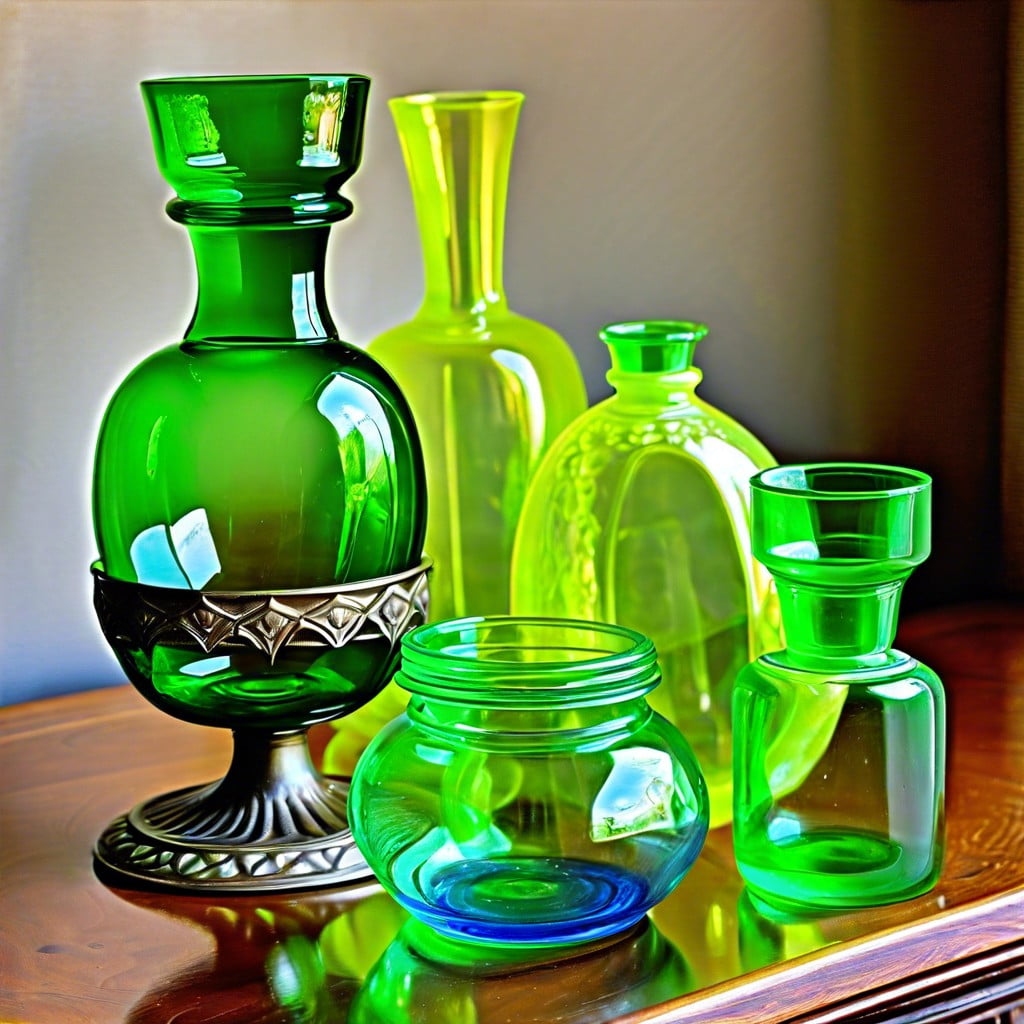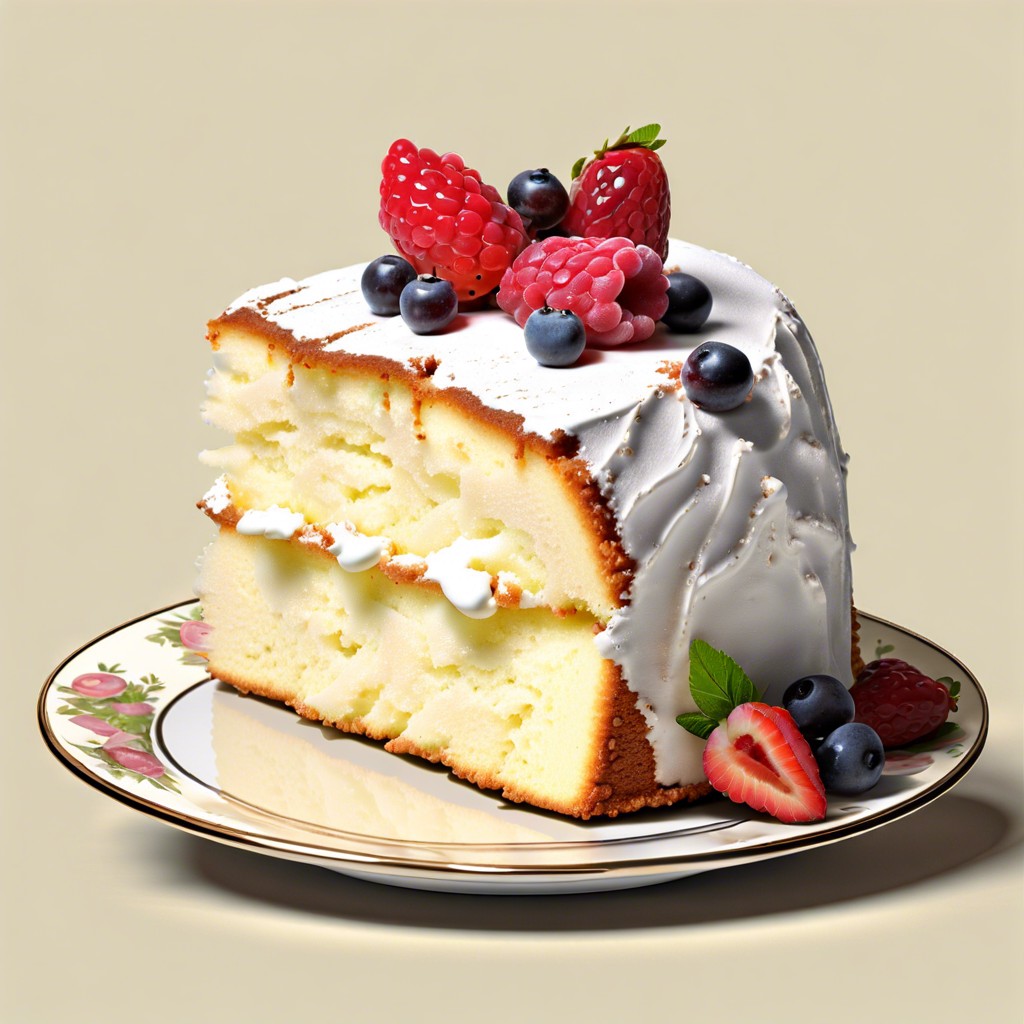Last updated on
Comparing Vaseline glass and uranium glass becomes an intriguing puzzle because they both showcase a rare phenomenon in the world of historic and decorative glasswork.
Key takeaways:
- Uranium glass and Vaseline glass both exhibit a rare phenomenon with their coloration and glow.
- Uranium glass contains varying amounts of uranium oxide, while Vaseline glass is a subset with a more pronounced yellow or yellow-green hue.
- Uranium glass has a wider color spectrum and may appear more opaque, while Vaseline glass is translucent and has a glossier finish.
- Both types of glass were popular in the late 19th to mid-20th century, primarily used for tableware and decorative pieces.
- Proper handling and use of these glass types pose minimal health risks, but precautions should still be taken.
Definitions and Terms

Understanding the vernacular is essential when discussing glass collectibles. Uranium glass, aptly named for its uranium content, typically exhibits a soft, yellow-green color. It is distinguishable under UV light, where it glows a vivid green due to the uranium. Vaseline glass, a subset of uranium glass, possesses a more pronounced yellow or yellow-green hue, reminiscent of petroleum jelly, from which its name is derived.
The varying uranium concentrations influence the intensity and coloration of these glasses. Despite their radioactive content, the amounts are generally considered to be very low and safe for handling under normal conditions. Both types are highly collectible, with color and glow serving as key identification traits for enthusiasts and experts alike.
Brief History of Uranium and Vaseline Glass

Uranium glass first appeared in the 19th century, gaining popularity for its fluorescent green color and its unique glow under ultraviolet light. Artisans initially added uranium dioxide to glass mixtures to achieve this distinctive coloration, a practice that has fluctuated in popularity over time due to various factors, including changes in aesthetics and concerns about the safety of radioactive materials.
Developed as a subset of uranium glass, Vaseline glass was named for its resemblance to petroleum jelly’s soft yellow color. It emerged during the same period and was particularly esteemed for its creamy fluorescence. Both types of glassware have experienced waves of revival, especially among collectors fascinated by their historic significance and striking appearance.
Production temporarily halted during the mid-20th century due to the prioritization of uranium for nuclear weapons and energy. Nevertheless, glassware enthusiasts continued to celebrate these pieces, often scouring antique shops and estate sales to find them. Today, uranium and Vaseline glass are appreciated for their unique place in the history of glassmaking and are often discussed in collectors’ circles.
Physical and Chemical Properties
Uranium glass contains uranium dioxide as a colorant and glows under ultraviolet light, with colors ranging from yellow to green. The uranium content can vary from 0.1% to over 25%, which directly influences the intensity of the green coloration and the glow.
On the other hand, Vaseline glass, a subset of uranium glass, has a distinctive oily or greasy appearance, typically in a yellow-green hue that also fluoresces under UV light. The physical density and refractive index of both glass types are similar to other glassware, but the presence of uranium can increase their weight and density.
Chemically, the glasses are essentially silicate glasses with the additive of uranium, which causes their distinct luminescent properties. The level of uranium can impact the glass’s resistance to weathering, with higher concentrations providing greater durability.
Differences Between Uranium Glass and Vaseline Glass
Uranium glass, recognized for its typically green coloration, owes its appearance to varying concentrations of uranium oxide. Its distinct glow under ultraviolet light offers a surefire method of identification. The hue ranges from yellow to green, and even a reddish tone depending on the ingredients and oxidation states of the uranium.
Vaseline glass, a subset of uranium glass, is lighter in color, often displaying a yellowish-green hue likened to petroleum jelly, hence its name. This glass type usually contains lower levels of uranium and sometimes includes additional additives like lead to enhance clarity and shine.
The primary distinction resides in color and opacity: Vaseline glass is characteristically more translucent and presents a slicker, glossier finish, while uranium glass exhibits a wider color spectrum and may appear more opaque. Despite their differences, both share the common trait of fluorescing under UV light, albeit with varying intensities.
Common Uses and Periods of Production
Uranium glass enjoyed peak popularity from the mid-19th century until the mid-20th century. It was frequently used for tableware, like cups, plates, and serving bowls, along with decorative items such as figurines and beads. During the Victorian era, its unique glow was particularly prized for adding a touch of opulence to households.
Similarly, Vaseline glass, which gets its name from its petroleum jelly-like coloration, was most popular from the 1880s to the 1920s. It was often crafted into ornamental glass pieces such as vases, lampshades, and canary-yellow glassware that glowed with an otherworldly light under ultraviolet light.
Both types of glass fell out of widespread production after World War II due to concerns over the use of uranium. However, there has been a resurgence in collecting these unique pieces, leading to limited production runs by specialty glassmakers keen on recreating the historical allure of these radioactive treasures.
Identifying Features of Uranium and Vaseline Glass
Uranium glass emits a characteristic green fluorescence under ultraviolet (UV) light due to uranium content, a definitive test for identification. Vaseline glass, a subset of uranium glass, possesses a yellow-green coloration and also fluoresces under UV light; however, its distinguishing characteristic is the greasy or oily sheen, akin to petroleum jelly, which gives it the name ‘Vaseline.’ This sheen is present with or without UV light.
When UV light isn’t available, look for a consistent, subtle green or yellow tint throughout the piece. Remember that the intensity of the color may vary depending on the concentration of uranium. In daylight, Vaseline glass often exhibits a bright, lemony hue while other types of uranium glass may just have a faint green tint.
Another clue lies in the thickness of the glass; Vaseline glass typically has a thinner construction due to its intended use for delicate items like tableware or decorative pieces, compared to more diverse uranium glass products.
Finally, consider the historical context. Items produced during the peak of uranium glass popularity, from the late 19th to the mid-20th century, are more likely to be authentic, though reproductions do exist. Collectors may use resources like pattern identification guides, spectral analysis for precision, and expert consultation for unambiguous identification.
Health and Safety Considerations
Despite the presence of uranium, which is a radioactive element, the levels found in both vaseline and uranium glass are generally considered to be too low to pose significant health risks under normal handling. The radioactivity is primarily due to the uranium content, and while it can be detected with a Geiger counter, it is not enough to cause radiation damage or health issues for collectors and users.
Proper handling and display, such as avoiding grinding or reshaping pieces that could release uranium dust, are good practices. For those concerned about the potential risks, limiting prolonged exposure and contact can provide peace of mind without detracting from the enjoyment of these unique pieces.
Usage is particularly safe when the glass serves decorative purposes. However, if using these antique items for food or drink, it is advisable to restrict such use to occasional rather than daily use, due to potential leaching of uranium, especially in acidic environments.
Most modern countermeasures for dealing with radioactive materials, like lead-lined boxes or protective gear, are unnecessary for vaseline or uranium glass due to their low level of activity. Still, collectors might choose to display them in areas with less frequent human presence as a precaution.
Ensuring these pieces are kept out of reach of children, who might be more susceptible to potential toxins, is also a sensible step. Another consideration includes careful cleaning to avoid ingesting any dust from the items that could potentially contain trace uranium.
In short, while some precautions should be considered, owning and displaying vaseline or uranium glass does not generally present serious health risks with sensible handling and use.
Market Value and Rarity
Both uranium and Vaseline glass have unique places in the collectors’ market, affected by condition, age, and rarity.
Condition: Pieces free of chips, cracks, or significant wear fetch higher prices.
Age: Older pieces, particularly those from the 19th or early 20th century, tend to be more valuable.
Rarity: Certain patterns and colors are less common and thus more sought after by collectors.
Provenance: Documented history or association with notable events or people can enhance value.
Collector demand fluctuates, with some periods seeing higher interest in these collectibles. Significantly, market value can soar for pieces that uniquely capture the culture of their manufacturing period or showcase exceptional craftsmanship. It’s important for collectors to research recent sale prices and consult with experts to gain an accurate understanding of current market values.
Care and Maintenance
To preserve the unique glow and integrity of your vaseline or uranium glass pieces, proper care is essential:
1. Gentle Cleaning: Use a soft cloth and mild detergent to clean the glass, avoiding abrasive materials that might scratch the surface. Warm water is often sufficient for most cleaning needs.
2. Avoiding Extreme Temperatures: Sudden temperature changes can cause glass to crack. When washing, ensure the water temperature is not too hot or too cold, and keep your glass away from direct sunlight that could magnify heat and cause damage.
3. Displaying Safely: Opt for a stable, level display area where the glass isn’t at risk of being knocked over. Consider using museum wax or putty to secure pieces in place if they are in high-traffic areas.
4. Regular Dusting: Use a feather duster or a soft, dry cloth to remove dust and maintain the glass’s sheen without the need for frequent washing.
5. Limit Use of Dishwashers: While some contemporary glass may be dishwasher safe, it’s advisable to hand-wash vintage pieces, as the harsh environment inside a dishwasher could etch or dull the glass over time.
By following these guidelines, you can help ensure your vaseline or uranium glass remains vibrant and treasured for years to come.
Legal and Manufacturing Status Today
The production and sale of glassware containing uranium, which includes both Vaseline and uranium glass, is still legal in the United States and many other countries. However, there are strict regulations for manufacturers due to the radioactive nature of uranium. The U.S. Nuclear Regulatory Commission stipulates that uranium in glass must be in concentrations lower than 25 percent by weight for unrestricted sale. Despite its radioactive content, the glass emits radiation at levels typically considered to be safe for handling and everyday use.
Modern artisans who wish to produce uranium glass must navigate a web of safety guidelines. They commonly employ depleted uranium, which has less radioactivity than the naturally occurring element, to lower health risks. Europe also maintains regulations regarding the use of radioactive materials in consumer goods, ensuring that uranium glass production does not pose a significant health threat.
Collectors and enthusiasts need not worry about legal restrictions when buying or selling antique pieces. These items are generally treated as safe, owing to their negligible radiation emission levels. However, importing and exporting antique uranium glass may be subject to regulation depending on the country’s laws concerning radioactive materials. It’s advisable to consult local regulations if engaging in international trade of uranium-containing glassware.




